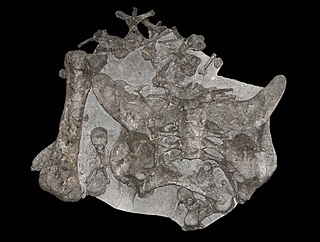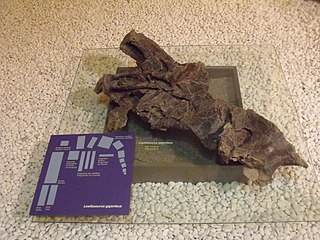
Camptosaurus is a genus of plant-eating, beaked ornithischian dinosaurs of the Late Jurassic period of western North America and possibly also Europe. The name means 'flexible lizard'.

Dacentrurus, originally known as Omosaurus, is a genus of stegosaurian dinosaur from the Late Jurassic and perhaps Early Cretaceous of Europe.

Aragosaurus was a genus of sauropod dinosaur from the Early Cretaceous period of Galve, province of Teruel, in the autonomous territory of Aragón, Spain. It was deposited in the Villar del Arzobispo Formation.

Lapparentosaurus is a genus of sauropod dinosaur from the Middle Jurassic. Its fossils were found in Madagascar. The type species is L. madagascariensis.

Lusotitan is a genus of herbivorous brachiosaurid sauropod dinosaur from the Late Jurassic of Portugal and possibly Spain.

Losillasaurus is a genus of sauropod dinosaur from the Late Jurassic and possibly Early Cretaceous (Kimmeridgian-?Berriasian) in the southeast of Spain. The type species of the turiasaurian Losillasaurus giganteus was discovered in the Villar del Arzobispo Formation in Valencia and formally described by Casanovas, Santafé and Sanz in 2001. The holotype material is from a subadult and includes part of a skull; complete cervical, dorsal, sacral, and caudal vertebrae as well as several fragments; skeletal elements from the limbs including a humerus, ulna, radius, and metacarpal; sternal plates; and from the pelvis: the ilium, ischium, and pubis. The genus is characterized by the dimension and shape of the neural spine of the proximal caudal vertebrae. The humerus is 143 centimetres (56 in) long, which despite being from a subadult specimen is within 20% of the size of Paralititan. The size estimation proposed by Francisco Gascó in his master thesis is 15–18 m (49–59 ft) and 12-15 tons.
Galvesaurus, or Galveosaurus, is a genus of brachiosaurid sauropod dinosaur from the Late Jurassic period. Fossils of the only known species, G. herreroi, were found in Galve, Spain, hence its generic name, "Galve lizard". The specific name G. herreroi honours the discoverer, José María Herrero. Some researchers suggest that the taxon might represent a junior synonym of Lusotitan.

Turiasaurus is a genus of sauropod dinosaurs. It is known from a single fossil specimen representing the species Turiasaurus riodevensis, found in the Kimmeridgian Villar del Arzobispo Formation of Teruel, Spain.

Turiasauria is an unranked clade of basal sauropod dinosaurs known from Middle Jurassic to Early Cretaceous deposits in Europe, North America, and Africa.

The Lourinhã Formation is a fossil rich geological formation in western Portugal, named for the municipality of Lourinhã. The formation is mostly Late Jurassic in age (Kimmeridgian/Tithonian), with the top of the formation extending into the earliest Cretaceous (Berriasian). It is notable for containing a fauna especially similar to that of the Morrison Formation in the United States and a lesser extent to the Tendaguru Formation in Tanzania. There are also similarities to the nearby Villar del Arzobispo Formation and Alcobaça Formation. The stratigraphy of the formation and the basin in general is complex and controversial, with the constituent member beds belonging to the formation varying between different authors.
Galve is a municipality located in the province of Teruel, Aragon, Spain. According to the 2006 census (INE), the municipality has a population of 145 inhabitants. There is an important paleontological site.

Tastavinsaurus is a genus of sauropod dinosaur belonging to the Titanosauriformes. It is based on a partial skeleton from the Early Cretaceous Xert Formation of Spain. The type species is Tastavinsaurus sanzi, named in honor of the Rio Tastavins in Spain and Spanish paleontologist José Luis Sanz. Tastavinsaurus sanzi is known from two specimens, one from the Xert Formation and one from the Forcall Formation. Tastavinsaurus was originally described as a somphospondylan, but it may be a brachiosaurid. The clade Laurasiformes was coined for Tastavinsaurus and its close relatives, which may include Cedarosaurus, Soriatitan, and Venenosaurus.

The Camarillas Formation is a geological formation in the Teruel Province of Aragón, Spain whose strata date back to the Early Cretaceous. The sandstones, mudstones and conglomerates of the formation, that due to syn-sedimentary faulting varies greatly in thickness from 300 to 800 metres, were deposited in fluvial, deltaic and lacustrine environments.

Miragaia is a long-necked stegosaurid dinosaur. Its fossils have been found in Upper Jurassic rocks in Portugal and possibly also Wyoming, United States. Miragaia has the longest neck known for any stegosaurian, which included at least seventeen vertebrae. Some researchers consider this taxon to be a junior synonym of Dacentrurus.

The Villar del Arzobispo Formation is a Late Jurassic to possibly Early Cretaceous geologic formation in eastern Spain. It is equivalent in age to the Lourinhã Formation of Portugal. It was originally thought to date from the Late Tithonian-Middle Berriasian, but more recent work suggests a Kimmeridigan-Late Tithonian, possibly dating to the Early Berriasian in some areas. The Villar del Arzobispo Formation's age in the area of Riodeva in Spain has been dated based on stratigraphic correlations as middle-upper Tithonian, approximately 145-141 million years old. In the area of Galve, the formation potentially dates into the earliest Cretaceous.

Dr. Rafael Royo-Torres is a Spanish Paleontologist. He works in Fundación Conjunto Paleontológico de Teruel-Dinópolis, in Teruel, Spain. He is one of the discoverers of Turiasaurus riodevensis, together with Luis Alcalá and Alberto Cobos.

Laurasiformes is an extinct clade of sauropod dinosaurs from the late Early Cretaceous of Europe, North and South America. It was defined in 2009 by the Spanish paleontologist Rafael Royo-Torres as a clade containing sauropods more closely related to Tastavinsaurus than to Saltasaurus. Genera purported to form part of this clade include Aragosaurus, Galvesaurus, Phuwiangosaurus, Venenosaurus, Cedarosaurus, Tehuelchesaurus, Sonorasaurus and Tastavinsaurus.

Mierasaurus is an extinct genus of sauropod dinosaur from the Early Cretaceous of Utah, United States. The taxon was first described and named in 2017 by Rafael Royo-Torres and colleagues, from a mostly complete skeleton including a disarticulated partial skull and mandible, teeth, multiple vertebrae from along the length of the body, both scapulae, radius and ulna bones, a left manus, a complete pelvis, both femora and the entire left hindlimb. Additionally, they referred a lower jaw and femur from juvenile individuals, which were found nearby, to the genus. Collectively, Mierasaurus is among the most completely known North American sauropods. The genus name honours Bernardo de Miera y Pacheco, the first European scientist to enter what is now Utah. The type species for Mierasaurus is Mierasaurus bobyoungi, named after Robert Glen Young, a paleontologist who researched the Early Cretaceous of Utah.

Oceanotitan is a genus of sauropod dinosaur known from the Upper Jurassic Lourinha Formation of Portugal. It is represented by a single specimen consisting of several tail vertebrae and appendicular bones. It contains one species, Oceanotitan dantasi. Oceanotitan is classified as possibly one of the earliest members of the Somphospondyli, a group of sauropods that includes the titanosaurs.

Narindasaurus is a genus of turiasaurian sauropod dinosaur from the Middle Jurassic Isalo III Formation of Madagascar. The type species, N. thevenini was formally described by Royo-Torres et al. in 2020. The holotype, which consists of one specimen, is currently stored at the Muséum national d’Histoire naturelle and has been since 1906 or 1907.





















